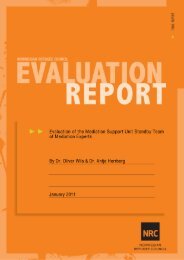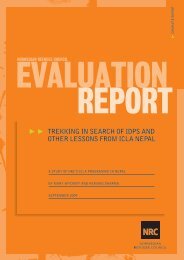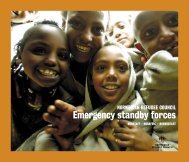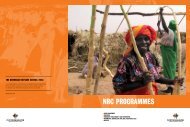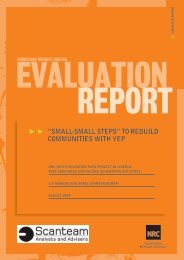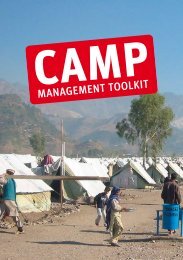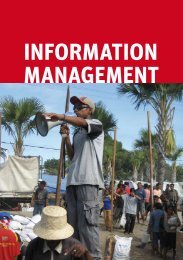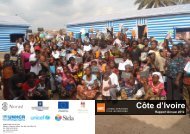evaluation of general food distribution in northern uganda: gulu ...
evaluation of general food distribution in northern uganda: gulu ...
evaluation of general food distribution in northern uganda: gulu ...
Create successful ePaper yourself
Turn your PDF publications into a flip-book with our unique Google optimized e-Paper software.
7.2 Project Objective 2To protect lives by provid<strong>in</strong>g humanitarian <strong>food</strong> assistance to IDPs to meet theassessed average net <strong>food</strong> gapBased on improv<strong>in</strong>g <strong>in</strong>dicators, the assumption made by WFP to reduce the <strong>food</strong> rations forNorthern Uganda <strong>in</strong> 2005 has been that ‘the IDP population will be able to contributesignificantly to their <strong>food</strong> needs with improvements <strong>in</strong> security and access to land’ 76 . WFPanticipated that with the improved security the IDP population <strong>of</strong> 1,6 million people woulddecrease by 321.500 <strong>in</strong> 2005, 643.000 <strong>in</strong> 2006 and 275.000 <strong>in</strong> 2007. ‘The residual caseload<strong>of</strong> 45.900 will not be targeted with relief assistance because it is assumed that most <strong>of</strong> themwill have access to land for cultivation’ 77 .However today we know that the process was different, especially <strong>in</strong> the Acholi region. Withthe delay <strong>in</strong> the peace talks and sign<strong>in</strong>g <strong>of</strong> the peace agreement, the cont<strong>in</strong>ued threat <strong>of</strong>Karamojong raiders from the east, seasonal floods and <strong>general</strong> trauma and fear <strong>of</strong> mov<strong>in</strong>ghome immediately, the return movement <strong>of</strong> IDPs and their ability to cultivate their land hastaken longer than anticipated. Although movements out <strong>of</strong> the camps have been pick<strong>in</strong>gpace (50% <strong>of</strong> IDPs left camps <strong>in</strong> Acholi sub region by Ma rch 2008) as described <strong>in</strong> Section3.2 on peace process and return, statistics show that many out <strong>of</strong> the orig<strong>in</strong>al 1.102.438 IDPs<strong>in</strong> Acholi are still <strong>in</strong> camps or have otherwise settled <strong>in</strong> transit sites, and may never moveback to their orig<strong>in</strong>al homesteads. Agricultural production is still tak<strong>in</strong>g a slow pace, as labourand farm <strong>in</strong>puts are few. Moreover, markets are not that easily accessible and other <strong>in</strong>comegeneration activities are few.Nevertheless changes <strong>in</strong> the <strong>food</strong> supply were made to all camps <strong>in</strong> late 2005. The rationalebeh<strong>in</strong>d the reduction <strong>in</strong> <strong>food</strong> rations was that IDPs from 2005 and onwards would be <strong>in</strong> abetter position to cover their net <strong>food</strong> gap 78 .7.2.1 The Evidence Base for Ration ReductionsIt is said that “<strong>food</strong> aid has historically been resource driven, not analysis driven” 79 . Onlyrecently has it been common that <strong>in</strong>formation systems for <strong>food</strong> aid capture morecomprehensive pictures <strong>of</strong> the context <strong>in</strong> which the actors are work<strong>in</strong>g 80 . In the case <strong>of</strong>Northern Uganda, Emergency Food Security Assessments (EFSA) and nutritional surveysprovide the context analysis and a broader basis for guidance and decision -mak<strong>in</strong>g for <strong>food</strong>ration reductions as well as <strong>in</strong>dications <strong>of</strong> peoples’ ability to cover their net <strong>food</strong> gap.NRC commonly participates together with WFP, other <strong>food</strong> security actors and the DistrictDisaster Management Committees (DDMC) <strong>in</strong> the Emergency Food Security Assessment.This section summarises the key f<strong>in</strong>d<strong>in</strong>gs <strong>of</strong> the EFSA <strong>of</strong> 2005 and 2007 81 .76 WFP, PRRO, 2005-200877 Ibid78 Net <strong>food</strong> gap is the difference between what IDPs and refugees can produce or access through market channels and them<strong>in</strong>imum recommended daily allowance (RDA) <strong>of</strong> 2100 kcal per person per day (WFP PRRO, 2005-2008)79 “Global Trends <strong>in</strong> Food Aid”, Daniel Maxwell, 2006, p. 680“Reth<strong>in</strong>k<strong>in</strong>g Food Security <strong>in</strong> Humanitarian Response”, Maxwell et al, 200881 The level <strong>of</strong> <strong>food</strong> assistance is determ<strong>in</strong>ed through assessments. WFP piloted an emergency <strong>food</strong> need methodology <strong>in</strong>2000 <strong>in</strong>clud<strong>in</strong>g both primary and secondary data from HH levels. Between 2000 and 2003 the EFNA was used to determ<strong>in</strong>e<strong>food</strong> aid needs. Today the EFNA has changed to the Emergency Food Security Assessment, EFSA, which employs a process<strong>of</strong> random sampl<strong>in</strong>g and more comprehensive data sources and variety. The plan has been to carry out an EFSA twice a year,however this does not always materialise. In stead a rapid <strong>food</strong> security review takes place. Source: EFSA 200530





